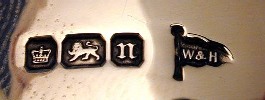

A silver object that is to be sold commercially is, in most countries, stamped with one or more silver hallmarks indicating the purity of the silver, the mark of the manufacturer or silversmith, and other (optional) markings to indicate the date of manufacture and additional information about the piece. In some countries, a national assayer's office controls the testing of silver objects and marking of purity.
Hallmarks are applied with a hammer and punch, a process that leaves sharp edges and spurs of metal. Therefore, hallmarking is generally done before the piece goes for its final polishing.
The hallmark for sterling silver varies from nation to nation, often using distinctive historic symbols, although Dutch and UK Assay offices no longer strike their traditional hallmarks exclusively in their own territories and undertake assay in other countries using marks that are the same as those used domestically.